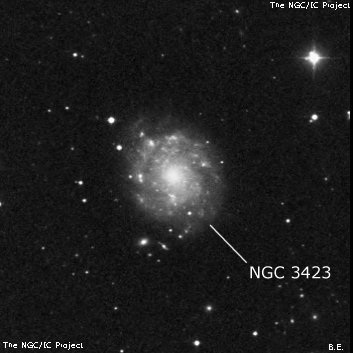
William Herschel discovered NGC 3423 = H IV-6 = H II-131 = h777 on 23 Feb 1784 (sweep 157) and recorded IV-6 as "F, L, cometic with a bright point in the center. The nebulous part is eF." His RA was 30 seconds too large. He found the nebula again on 13 Apr 1784 (sweep 191) and logged H. II-131 as "pB, vL, almost R, lbM, r." The RA on this sweep was 1 min too large and 5' too far south. Another observation was made on 2 Feb 1786 (sweep 521): "pB, vL, R, vgbM, about 5' dia."
John Herschel made 3 observations under h777 and equated his father's two entries, though he mistakenly also equated H. III-88 (NGC 3401). While compiling the NGC, Dreyer sorted out the identities IV-6 = II-131 = h777 = NGC 3423.
Bindon Stoney, observing on 7 Mar 1851 at Birr Castle, noted "2 knots [HII regions] on n side." On the 29 Mar 1856 observation, R.J. Mitchell noted a "star in the south edge, another fainter in f edge, 2 knots in n edge. I think it is resolvable."
400/500mm - 17.5" (4/6/91): moderately bright, fairly large, elongated 3:2 SSW-NNE, 3'x2', fairly low surface brightness, elongated bright core appears offset to the west. Has a faint halo which seems more extensive to the east of the core. Two mag 12/13 stars are off the NE edge with the mag 12 star 2.4' from the center.
900/1200mm - 48" (4/16/15): very bright, large, slightly elongated SW-NE, ~3'x2.5', large bright core. A mag 15.8 star is superimposed on the SSW side, 1.2' from center. Spiral structure is evident at 488x, particularly along a curving outer arm running from clockwise from east to north. This arm contains three HII knots.
An obvious faint knot, 8"-10" diameter, is at the north end 1.1' from center. The brightest knot is at the northeast end of the halo 1.1' from center, and it appeared fairly faint/faint, round, 12" diameter. The faintest knot (SDSS J105118.10+055024.7) is directly east of center by 1.0' and noted as very faint, round, 6" diameter. In addition to these three, a 4th knot is due south of center by 0.6'. This HII region was very faint, round, 8" diameter.
Two additional objects were seen just off the south side of NGC 3423, but these are separate galaxies. 2MASX J10511769+0548323, situated 2.0' SE of the center, is fairly faint to moderately bright (V = 15.7), small, round, moderate surface brightness, 15" diameter. 2MASX J10511769+0548323, 2.0' S of center, is very faint (V = 17.1), very small, ~9"x6" SW-NE. This latter galaxy has a redshift of z = .069 and lies far in the background at a light-travel time of ~920 million years.
Notes by Steve Gottlieb